Young trees have lots of potential but mature trees are more valuable. They provide shade, give fruit if they are fruit trees and are stable enough to survive harsh weather. This is the principle behind the Mishnah that tells us that a young tree is included in the sale of a field but a mature tree is not:
“and not the carob tree that has been grafted, and not the sycamore trunk (sadan).” (Bava Batra 68b)
Why are these two trees singled out for special treatment? Dr. Moshe Raanan explains that a grafted carob is a valuable tree. Some species of carob have edible fruits while others are not good for (human) consumption. If someone has gone to the trouble of grafting a branch with good fruit onto a strong trunk, it is economically significant and you would not include it in the sale of your field. In addition, carobs, like dates, have male and female varieties. As young trees you cannot always determine their sex and so you would take a known female or male tree and graft it onto the unknown tree. Then if you have one male that will pollinate your orchard, you will not want to get rid of it, while a female will give you desired fruit.
Unlike the carob, the shikma, or sycamore fig in English (not to be confused with the sycamore familiar in North America), does not yield very good fruits. However, its wood is very useful for building. In order to get the straight and sturdy planks to grow in, the shikma has to be trimmed in a certain way. Once this trimming is done you have what the Mishnah calls the sadan. After the trimming, the planks will continue to grow back, giving you a very valuable tree.
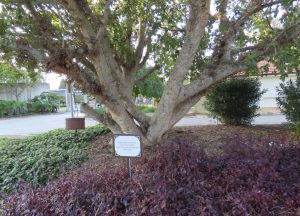
Sycamore in Kibbutz Hafetz Hayim with multiple trunks (sadan)
יעקב, CC BY-SA 4.0 <https://creativecommons.org/licenses/by-sa/4.0>, via Wikimedia Commons
Carobs and sycamores are paired together in other laws as well. If they grow too close to an irrigated field, they need to be trimmed since they cast too much shade (Bava Batra 27b). Dr. Raanan explains that other trees like figs also have a broad canopy and cast a lot of shade but they are deciduous and so in the winter, when they lose their leaves, other plants can grow under them. But the carob and the shikma keep their foliage all year and so they cut off sunlight to anything underneath them.
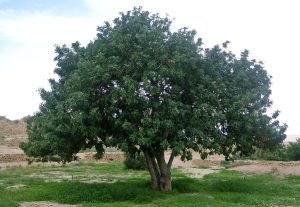
Broad canopy of a carob
Wilson44691, CC0, via Wikimedia Commons
Carobs are native to our part of the world and you can see them in many places in Israel. To watch the fruit grow from tiny green berries to elongated brown pods is to witness a wonderful transformation. Although the carob appears in many places in the Mishnah and the Talmud, it is not mentioned in the Bible. Rabbi Saadia Gaon identifies the נכאות (usually translated as ladanum) that Jacob sends to Egypt as carobs but no other commentator agrees with him (Bereshit 43:11). In any case, carobs are not mentioned by their real name חרוב anywhere in the Bible. Why is this? It seems that while carobs grew naturally in Israel in Biblical times, they were only intensively cultivated later, in Second Temple times. Rabbi Yisrael Rozenson thinks that because the carob’s natural habitat is the lowlands and the coast, not the mountains, that could also explain why they are missing in the Bible. Israelite settlement was primarily in the mountains which was not a carob growing place.
In any case, by the time of the Mishnah carob trees were part of the landscape and carobs were a staple of the Jewish diet. They were considered poor people’s food, something you could subsist on even if you had little else. Carobs do have a high calorie count and contain many nutrients. Three famous sages lived on nothing but carobs for years. One was Rabbi Hanina ben Dosa, a known ascetic in whose merit the world continues to exist (Berachot 17b). The other two were Rabbi Shimon bar Yohai and his son Elazar who hid from the Romans in a cave for twelve years. The midrash relates that a spring miraculously flowed near the entrance to a cave and a carob tree grew there and that was enough for their needs. (Shabbat 33b)
The name carob/חרוב has been explained in a number of ways. Some suggest that the fruit looks like a sword, a חרב. Others suggest that it comes from the root חרב, dry, since the fruits are dried and the tree can survive in dry conditions.
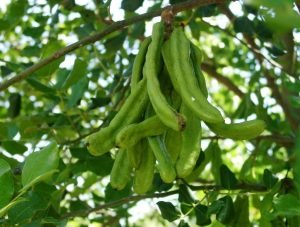
Júlio Reis (Tintazul), CC BY-SA 2.5 <https://creativecommons.org/licenses/by-sa/2.5>, via Wikimedia Commons
A carob tree appears in the famous story about the oven of Achnai (Bava Metzia 59b). When Rabbi Eliezer ben Hyrcanos wishes to show that God is on his side in a halakhic argument, he miraculously has a carob tree jump from one place to another. The fact that mature carobs are large with thick trunks and wide canopies makes the miracle even greater. Carobs also feature prominently in the tale of Honi HaMaagel (see here for more about Honi). Honi sees a man planting a carob tree. He asks him how long it will take for the carob to bear fruit. Upon hearing that it will take seventy years, Honi is amazed – you clearly will never see fruit from this tree! The man’s answer, I plant for my children, teaches us that ideas about ecology and sustainability existed in Judaism long before they became fashionable in the modern world (Taanit 23a).
Carob seeds are (mostly) uniform, weighing about 200 milligrams. There were not too many uniform things in the ancient world so they were used as a basis to measure precious stones and metals. A carob seed is the weight of a gerah, as Ibn Ezra explains in this verse:
“This is what everyone who is entered in the records shall pay: a half-shekel by the sanctuary weight—twenty gerahs to the shekel—” (Shmot 30:13)
Ibn Ezra’s commentary: this gerah is the seed of a carob
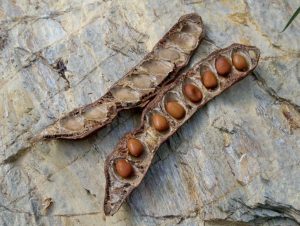
Daniel Capilla from Málaga, España, CC BY-SA 2.0 <https://creativecommons.org/licenses/by-sa/2.0>, via Wikimedia Commons
The word itself evolved into “carat,” one seed equaling one carat. A pure Roman gold coin called a solidus contained the weight of twenty four carob seeds. As a result, 24-carat gold became the “gold standard,” something that is 100% gold. Today, diamonds have much more precise measurements but we still brag about having a 1, 2 or 10 carat diamond.
Is a grafted carob tree worth its weight in diamonds?
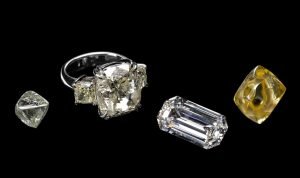
Smithsonian Institution, Public domain, via Wikimedia Commons










